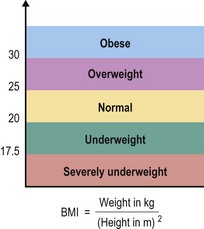Eating disorders
Anorexia nervosa
Concerns about weight, and dieting in order to lose weight are extremely common in the general population, particularly among young women. Anorexia nervosa represents an extreme form of this behaviour. Fear of being fat leads to the adoption of a starvation diet. Weight falls to at least 15% below normal, so that the body mass index (BMI) is 17.5 or less (Fig. 1). Despite this, anorexics continue to believe they are overweight, even when faced with their emaciated reflection in the mirror. This distorted body image drives them to continue to lose weight, and they may adopt other methods such as excessive exercise, self-induced vomiting or abuse of laxatives, diuretics or appetite suppressants such as amphetamine. They may become preoccupied with food, hoarding it, or becoming very interested in cookery, creating elaborate meals for their family while still refusing to eat. Amenorrhoea occurs in the early stages of weight loss and is an indication of a widespread endocrine disorder. Figure 2 shows the signs and symptoms found in anorexia nervosa.
Aetiology
Predisposing factors
 Cultural factors. Anorexia nervosa and bulimia nervosa are disorders of the food-rich developed world. Western society has developed a stereotyped view of physical attractiveness which equates ‘thin’ with ‘beautiful’, and promotes negative attitudes about obesity. The media bombard us with idealised images of underweight models alongside advertisements for confectionery. Adolescents are particularly vulnerable to these cultural pressures to conform and to be attractive.
Cultural factors. Anorexia nervosa and bulimia nervosa are disorders of the food-rich developed world. Western society has developed a stereotyped view of physical attractiveness which equates ‘thin’ with ‘beautiful’, and promotes negative attitudes about obesity. The media bombard us with idealised images of underweight models alongside advertisements for confectionery. Adolescents are particularly vulnerable to these cultural pressures to conform and to be attractive. Genetic factors. Twin studies have shown that genetic factors do play a role, probably by creating a vulnerability to weight loss so that in the presence of environmental pressures an eating disorder may develop.
Genetic factors. Twin studies have shown that genetic factors do play a role, probably by creating a vulnerability to weight loss so that in the presence of environmental pressures an eating disorder may develop.Stay updated, free articles. Join our Telegram channel

Full access? Get Clinical Tree





